Review: Edge of the Universeby Jeff Foust
|
| Halpern likens the era of “recombination” in the early universe, when electrons and protons combined to form neutral atoms, to a dinner party, and the ease to which waiters (aka photons) can traverse a room. |
Halpern, a physics professor at the University of the Sciences in Philadelphia, provides a guide in this book to our current state of understanding, or lack thereof, in cosmology today. He takes more of a topical than historical approach: rather than marching through a chronology of discoveries and theories, he looks at our current state of understanding of a variety of topics, starting with the Big Bang origins of the universe and the inflation model most widely accepted today to the discovery—and continued mystery—of dark energy that is causing the expansion of the universe to accelerate, perhaps to the point of ripping the universe apart. Then Halpern takes on dark matter and a grab bag of other cosmological mysteries, from gamma-ray bursts to the so-called “dark flow” of galaxies moving at high speed to an unseen attractor.
Halpern writes for the educated layperson, and excels at using analogies to describe abstract astronomical concepts in terms easier to understand. For example, he likens the era of “recombination” in the early universe, when electrons and protons combined to form neutral atoms, to a dinner party. Before recombination, the dinnger guests mingled, making it difficult for waiters—the photons in this analogy—to make it across the room. Once the guests were “paired up” at the dinner table, the waiters could now easily move across, just as the universe went from being opaque to transparent when recombination took place. These analogies are particularly important since the book, curiously, lacks any images or illustrations commonly found in astronomy books to help describe these topics.
For those already familiar with the current state of cosmological research, perhaps from the steady stream of books published on the topic, there’s not much new to come from Edge of the Universe. Halpern covers some familiar ground, and isn’t espousing a favorite theory or line of research he’s involved in (the book’s endnotes show a reliance on news articles and popular, rather than technical, publications.) For those looking for a readable introduction on the subject, though, or who are simply befuddled about cosmology, this book useful, highly readable overview of the topic. Keep in mind, though, that the questions about the universe still outnumber the answers. As Halpern writes near the end of the book, “it is the best of times and the weirdest of times in cosmology.”
